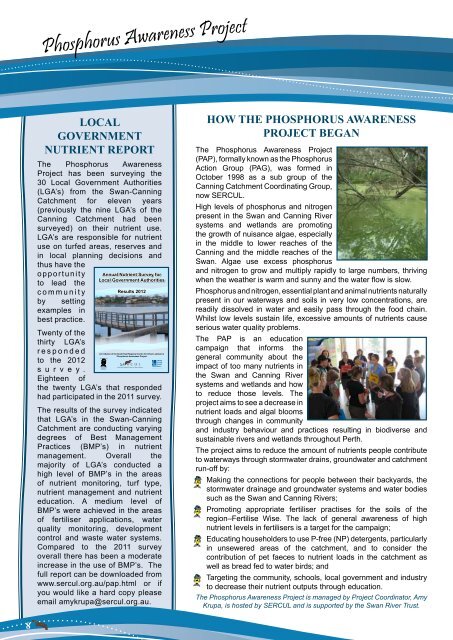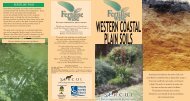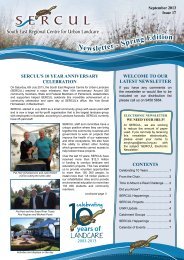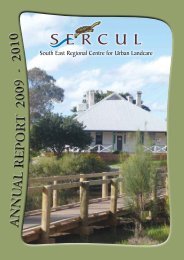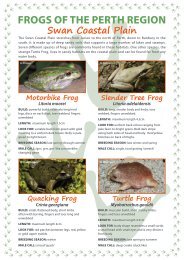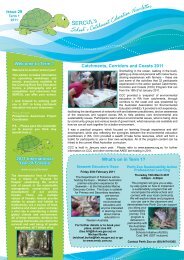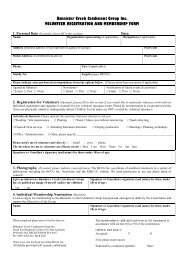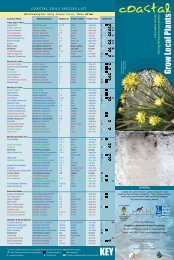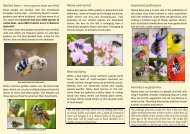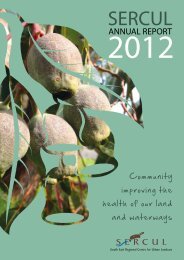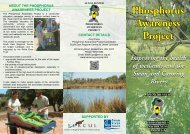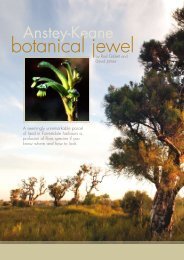Summer 2013 Newsletter - SERCUL
Summer 2013 Newsletter - SERCUL
Summer 2013 Newsletter - SERCUL
You also want an ePaper? Increase the reach of your titles
YUMPU automatically turns print PDFs into web optimized ePapers that Google loves.
Printed on 100% recycled paper.<br />
ALGAE BUSTER<br />
PHOSPHORUS<br />
AWARENESS<br />
PROJECT<br />
Caring for the Swan Canning Riverpark<br />
Phosphorus Awareness Project<br />
LOCAL<br />
GOVERNMENT<br />
NutRient report<br />
The Phosphorus Awareness<br />
Project has been surveying the<br />
30 Local Government Authorities<br />
(LGA’s) from the Swan-Canning<br />
Catchment for eleven years<br />
(previously the nine LGA’s of the<br />
Canning Catchment had been<br />
surveyed) on their nutrient use.<br />
LGA’s are responsible for nutrient<br />
use on turfed areas, reserves and<br />
in local planning decisions and<br />
thus have the<br />
opportunity<br />
to lead the<br />
community<br />
by setting<br />
examples in<br />
best practice.<br />
Annual Nutrient Survey for<br />
Local Government Authorities<br />
Results 2012<br />
Twenty of the<br />
thirty LGA’s<br />
responded<br />
An initiative of the South East Regional Centre for Urban Landcare’s<br />
Phosphorus Awareness Project<br />
This report has been prepared for the Phosphorus Awareness Project,<br />
to South East Regional Centre for Urban Landcare, 2012.<br />
s u r v e y .<br />
Eighteen of<br />
the twenty LGA’s that responded<br />
had participated in the 2011 survey.<br />
The results of the survey indicated<br />
that LGA’s in the Swan-Canning<br />
Catchment are conducting varying<br />
degrees of Best Management<br />
Practices (BMP’s) in nutrient<br />
management. Overall the<br />
majority of LGA’s conducted a<br />
high level of BMP’s in the areas<br />
of nutrient monitoring, turf type,<br />
nutrient management and nutrient<br />
education. A medium level of<br />
BMP’s were achieved in the areas<br />
of fertiliser applications, water<br />
quality monitoring, development<br />
control and waste water systems.<br />
Compared to the 2011 survey<br />
overall there has been a moderate<br />
increase in the use of BMP’s. The<br />
full report can be downloaded from<br />
www.sercul.org.au/pap.html or if<br />
you would like a hard copy please<br />
email amykrupa@sercul.org.au.<br />
For further information please contact Amy Krupa on 9458 5664 or email amykrupa@sercul.org.au<br />
How the Phosphorus Awareness<br />
Project Began<br />
The Phosphorus Awareness Project<br />
(PAP), formally known as the Phosphorus<br />
Action Group (PAG), was formed in<br />
October 1998 as a sub group of the<br />
Canning Catchment Coordinating Group,<br />
now <strong>SERCUL</strong>.<br />
High levels of phosphorus and nitrogen<br />
present in the Swan and Canning River<br />
systems and wetlands are promoting<br />
the growth of nuisance algae, especially<br />
in the middle to lower reaches of the<br />
Canning and the middle reaches of the<br />
Swan. Algae use excess phosphorus<br />
and nitrogen to grow and multiply rapidly to large numbers, thriving<br />
when the weather is warm and sunny and the water flow is slow.<br />
Phosphorus and nitrogen, essential plant and animal nutrients naturally<br />
present in our waterways and soils in very low concentrations, are<br />
readily dissolved in water and easily pass through the food chain.<br />
Whilst low levels sustain life, excessive amounts of nutrients cause<br />
serious water quality problems.<br />
The PAP is an education<br />
campaign that informs the<br />
general community about the<br />
impact of too many nutrients in<br />
the Swan and Canning River<br />
systems and wetlands and how<br />
to reduce those levels. The<br />
project aims to see a decrease in<br />
nutrient loads and algal blooms<br />
through changes in community<br />
and industry behaviour and practices resulting in biodiverse and<br />
sustainable rivers and wetlands throughout Perth.<br />
The project aims to reduce the amount of nutrients people contribute<br />
to waterways through stormwater drains, groundwater and catchment<br />
run-off by:<br />
•<br />
Making the connections for people between their backyards, the<br />
stormwater drainage and groundwater systems and water bodies<br />
such as the Swan and Canning Rivers;<br />
•<br />
Promoting appropriate fertiliser practises for the soils of the<br />
region–Fertilise Wise. The lack of general awareness of high<br />
nutrient levels in fertilisers is a target for the campaign;<br />
Educating householders to use P-free (NP) detergents, particularly<br />
•<br />
in unsewered areas of the catchment, and to consider the<br />
contribution of pet faeces to nutrient loads in the catchment as<br />
well as bread fed to water birds; and<br />
•<br />
Targeting the community, schools, local government and industry<br />
to decrease their nutrient outputs through education.<br />
The Phosphorus Awareness Project is managed by Project Coordinator, Amy<br />
Krupa, is hosted by <strong>SERCUL</strong> and is supported by the Swan River Trust.<br />
8


